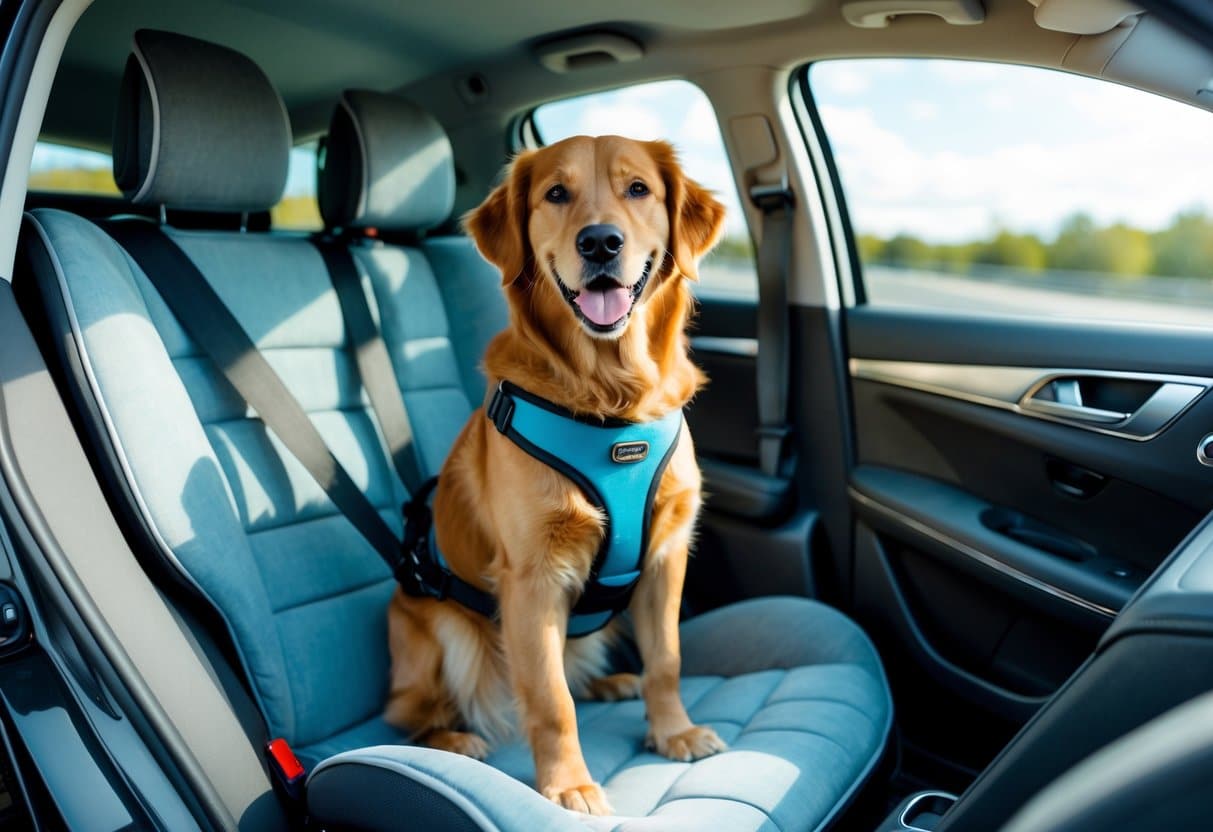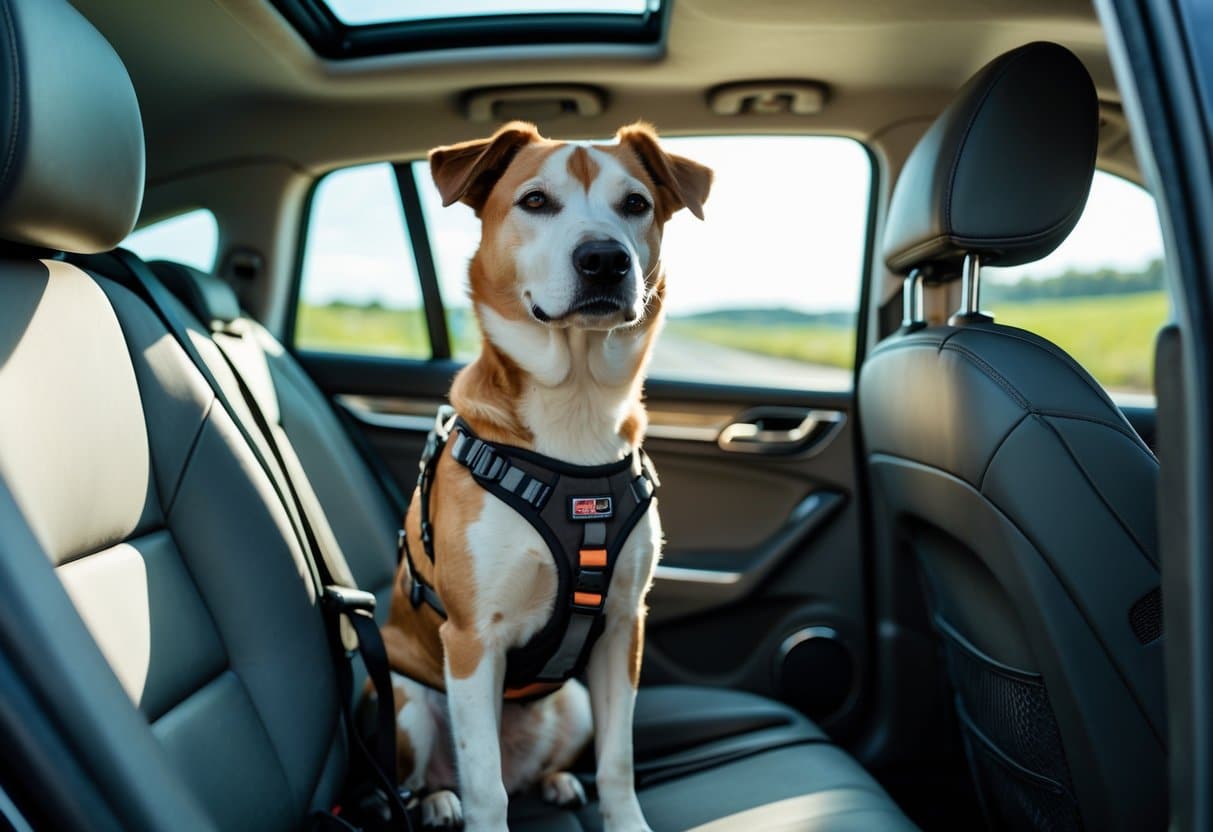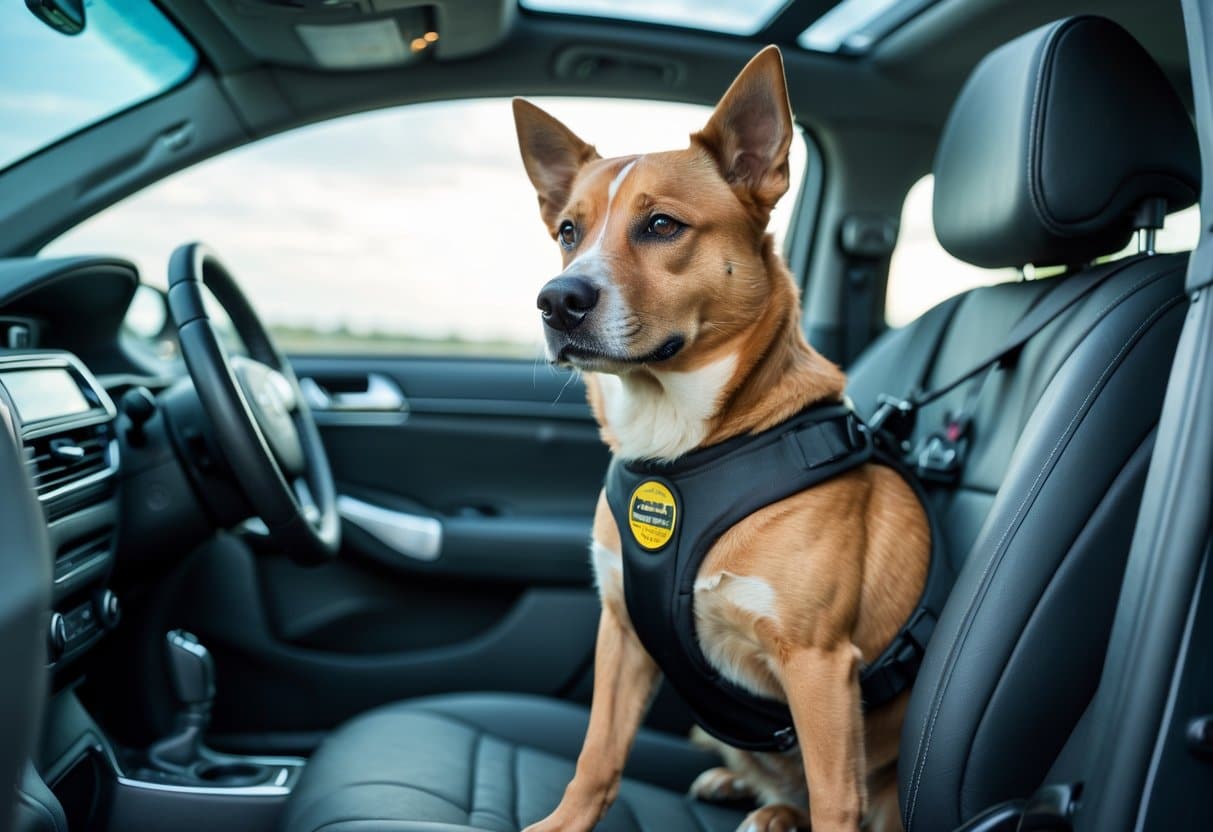
Taking your dog on a long road trip? You’ll need the right safety gear to keep your furry co-pilot protected.
The best dog car restraints for long distance travel are crash-tested harnesses like the Sleepypod Clickit Sport or spacious car seats such as the MIXJOY Dog Car Seat & Hammock. These are designed to keep dogs secure during sudden stops and accidents, and honestly, they do help with travel anxiety too.
Most folks don’t realize it, but an unrestrained 60-pound dog can turn into a 2,700-pound projectile in a 35-mph crash. The right car restraint system isn’t just about the dog—it’s about protecting everyone in the car.
Crash-tested dog harnesses and car seats are specifically built and tested to handle collision forces. They’re not just for show.
Traveling long distances with a dog is a whole different beast. Dogs need good airflow, comfy padding, and enough room to shift around during those marathon drives.
The best restraints out there blend safety certifications with extras like waterproof fabrics, handy pockets, and covers that are easy to clean. Makes road trips less of a hassle for everyone involved.
Key Takeaways
- Crash-tested harnesses and car seats give crucial protection in accidents and sudden stops
- The best restraint balances safety certifications with comfort features for those longer hauls
- Getting the right size and installing it properly is just as important as picking the brand
Why Dog Car Restraints Matter for Long Distance Travel

Unrestrained dogs aren’t just cute distractions—they’re a serious safety hazard in the car, especially on long trips. A proper dog safety harness for car travel can cut injury risk by up to 75% during a crash.
Some states even require pet restraints by law. So it’s not just a suggestion anymore.
Multi-Functional Dog Carrier for Car with Detachable Washable Cover, Pet Travel Bed with Clip-On Safety Leash, Grey
Risks of Unrestrained Dogs in Cars
Picture this: a 60-pound dog, loose in the car, becomes a 2,700-pound missile in a 35 mph collision. That’s enough force to seriously injure passengers—and the pet, of course.
Dogs without restraints can also distract drivers, block mirrors, or even hop onto your lap. Some have even managed to hit gear shifts or window buttons in a panic.
Physical risks to dogs include:
- Head and spinal injuries from impact with windows or seats
- Internal organ damage from crushing forces
- Broken bones from being thrown against hard surfaces
- Ejection through windows in severe crashes
The cramped space of a car just makes things worse. Dogs can’t brace themselves like people do, so even a minor fender-bender can turn ugly fast.
And the longer you’re on the road, the more opportunities there are for something to go wrong. That’s just how it is.
Crash-Test Data and Real Accident Outcomes
The Center for Pet Safety (CPS) runs some of the toughest crash tests in the business. Their findings? Most pet restraints actually fail basic safety tests.
Only three car harnesses have been crash test certified by the CPS as of 2025. Those few earned 5-star ratings after surviving simulated highway-speed crashes.
Real accident data shows:
- Unrestrained pets lead to 30,000 accidents each year in the US
- 84% of pet owners aren’t restraining their dogs properly
- Restrained dogs have triple the survival rates in serious crashes
- Property damage averages $2,400 more when pets become projectiles
Independent automotive safety engineers have found big differences between brands. Some harnesses claim they’re “crash-tested” but never actually passed those tests—watch out for that marketing trick.
The bottom line? A dog car harness or seat needs to spread crash forces across the dog’s strongest body parts and stop them from flying around the cabin.
Belt Harness for Dogs (Medium, Robin Egg Blue)
Legislation and Legal Requirements
In most states, unrestrained pets count as a driver distraction under traffic laws. Cops can and do write tickets if your dog is interfering with your driving.
State-specific requirements include:
- Hawaii: Pets must be in carriers or restrained in moving vehicles
- New Jersey: $250-1000 fines for improperly transported animals
- Connecticut: Animal cruelty charges possible for unsafe pet transport
- Rhode Island: Dogs can’t ride in drivers’ laps
Insurance companies are starting to deny claims if an unrestrained pet is involved in an accident. They’ll say you were negligent for not securing your animal.
Commercial drivers have it even stricter. DOT rules ban loose animals in trucks and buses crossing state lines.
Honestly, the legal trend is moving toward making pet restraints mandatory, just like child seats. Getting ahead of those rules is probably the smart move.
Crash-Tested Dog Car Seats and Harnesses: What to Look For

Center for Pet Safety (CPS) certification is the gold standard for dog car restraints. But material strength and sizing matter just as much when it comes to protecting your pup in a crash.
Understanding CPS Certification
CPS sets the industry’s toughest standards for testing dog car restraints. If a product is CPS-certified, it’s passed crash tests that mimic real accidents at up to 30 mph.
Plenty of brands claim “crash-tested” status, but unless it’s CPS-certified, it may not mean much. Only CPS-certified products have gone through independent, rigorous testing that’s similar to what child car seats get.
The Sleepypod Clickit Sport Plus is certified by the Center for Pet Safety and meets U.S., EU, and Canadian child safety standards. That certification checks how well the harness keeps your dog from becoming a projectile in a wreck.
Some products are tested at facilities using Federal Motor Vehicle Safety Standards, which is also solid, but CPS certification is still the most thorough check you’ll find for pet travel gear.
Material Strength and Durability Features
Ballistic nylon and reinforced stitching are must-haves in crash-tested dog restraints. They’re tough enough to handle the brutal forces of a car crash.
Metal hardware outperforms plastic every time. All hardware should be strong metal so it doesn’t snap during a collision.
Padded chest pieces help spread crash forces across your dog’s body. Memory foam isn’t just for beds—it adds comfort on the road and extra protection if something goes wrong.
The spots where the harness attaches to your car’s seat belt need to be reinforced. Look for proof of static tensile testing; every part should be able to take a hit.
Proper Sizing and Fit for Your Dog
Getting the right size is critical. Measure your dog’s chest at the widest point, and the neck, following whatever the manufacturer says (they all have their quirks).
If your dog’s between sizes, go with the bigger one. You can always tighten things up, but a harness that’s too small won’t protect them properly.
Most crash-tested harnesses fit dogs from about 18 to 90 pounds. Tiny breeds and toy dogs might not fit well in standard crash-tested harnesses, which is a bummer.
Try the harness at home before hitting the road. It should be snug but not tight, letting your dog sit or lie down easily while keeping them from sliding all over the place if you brake hard.
Top Crash-Tested Dog Car Harnesses for Long Trips
These three harnesses have passed tough safety tests at certified labs and offer the comfort features dogs need for long rides. Each has its own perks when it comes to certification, ease of use, and padding.
Sleepypod Clickit Sport
The Sleepypod Clickit Sport Plus is the top pick for crash-tested dog harnesses for car travel. It’s certified by the Center for Pet Safety after a battery of tests.
Safety Certifications:
- U.S., EU, and Canadian child safety standards
- Center for Pet Safety independent testing
- Federal Motor Vehicle Safety Standard compliance
The harness is lighter than most, yet packs in plenty of padding. That helps reduce injury risk and keeps your dog comfy on long drives.
Key Features:
- Light weight with strategic padding
- Switches easily from car to walking harness
- Easy to put on and take off
- Comes in seven colors
Best fit is for dogs between 18 and 90 pounds. Toy breeds might still have trouble, even with the smallest size. Adjusting the straps takes a little patience, but once you get it right, it stays put.
Kurgo Impact
The Kurgo Tru-Fit Enhanced Strength harness is a great value for pet owners who want safety without a steep price. It’s been tested at a university lab using Federal Motor Vehicle Safety Standard No. 213a protocols.
This harness has a clever design: carabiners stay attached to the seat belt, so you only have to undo the harness straps when getting your dog out.
Adjustment Features:
- Five different adjustment points
- Front and back leash clips
- Sizes from X-small to X-large
- Four color options
It holds up well in crashes, but can feel a bit restrictive when buckled. Small dogs might find it heavy for long trips. The sturdy build means it’s not the lightest option out there.
EzyDog Drive Harness
The EzyDog Drive Safety Travel harness represents the premium choice for pet owners who care about top-notch safety. Testing happened at Australia’s Automotive Safety Engineering facility, which, honestly, is pretty legit—recognized by European, Australian, and American regulatory agencies.
Premium Features:
- Ergonomic memory foam chest piece
- Step-in design for easy use
- Substantial construction materials
- Black color option only
The memory foam chest piece hugs your dog’s body shape, which is great for comfort. It helps cut down on pressure points during those endless car rides.
The step-in design means you don’t have to wrestle a harness over your dog’s head. It just makes the whole process less of a hassle.
Size Limitations:
- Available in small, medium, and large only
- Higher price point than competitors
- Fit may not work for all body types
The sturdy build offers standout crash protection, but yeah, you’ll pay more for it. Some dogs might need a different size than you’d assume from the usual measurements—always double-check before buying.
Choosing the Right Dog Car Seat for Your Pet’s Size and Travel Needs
The right dog car seat really depends on your dog’s weight, height, and how they act in the car. Small dogs do better with booster seats—they need to see out the window, right?
Bigger breeds? They need sturdier, roomier seats with legit crash-tested features. No one wants a cramped Labrador on a road trip.
Best Dog Car Seats for Small and Medium Breeds
Small and medium dogs (up to about 25 pounds) get the most out of booster-style car seats that give them a view. Not seeing outside can make them queasy or anxious.
Key features for small to medium dogs:
- Elevated design (3-4 inches of lift)
- Soft fleece or sherpa lining for comfort
- Built-in safety tether that clips to harness
- Storage compartments for treats and toys
Breeds like Chihuahuas, Yorkies, and Cocker Spaniels usually settle better with that extra boost. The view helps them feel less boxed in.
Lots of small dog owners want seats with removable cushions you can toss in the wash. If your pup is under 15 pounds, look for models specifically tested for tiny breeds—regular ones might be too big and, honestly, less safe.
Best Options for Large Breeds
Large dogs (think 50-80 pounds) need car seats with reinforced bottoms and plenty of width. For them, it’s way more about safety and space than height.
Essential features for large breeds:
- Hard bottom construction to prevent sagging
- Waterproof materials for easy cleanup
- Non-slip base for stability during turns
- Side barriers to prevent falling into footwells
Most large breed seats run about 28-32 inches long and 20-22 inches wide. German Shepherds, Labs, Goldens—they all need that extra sprawl room for comfort on long trips.
The best dog car seat options for larger dogs usually fold up for storage, which is handy. Some even let a person sit next to the dog, so you don’t give up the whole back seat.
Convertible and Booster Seat Solutions
Convertible dog car seats are pretty clever—they double as beds, carriers, and car restraints. If you travel a lot, having one thing that does it all is a win.
Convertible seat benefits:
- Functions as home bed and travel carrier
- Reduces pet anxiety through familiar scents
- Often includes airline-approved certifications
- Crash-tested safety ratings
Yeah, you’ll pay more up front for a convertible booster seat, but it pays off if you use it everywhere. Some switch from an elevated seat to a flat bed by just pulling out the cushion insert.
Multi-functional dog car seats are a lifesaver for dogs who bounce between cars, hotels, and campsites. Familiarity helps them chill out and sleep better, even on the road.
Some models have mesh domes for airflow and fleece bedding that pops out for washing. Super practical if your dog drools or sheds like crazy in the car.
Dog Crates and Alternative Restraints for Vehicle Travel
Crash-tested dog crates offer the most protection in a crash. Dog safety seats and harnesses are out there too, but each has its own pros and cons depending on your dog’s size and how your car is set up.
Crash-Tested Dog Crates
Dog crates built for travel are the gold standard for long road trips. They’re put through serious tests to make sure they can handle a collision.
The best ones use reinforced steel frames and sturdy latches. They attach to anchor points or seat belts in your car.
Most include ventilation panels and cushy interiors, so your dog isn’t miserable the whole time. That matters more than you’d think.
Key features of quality travel crates:
- Steel or aluminum construction
- Multiple attachment points
- Ventilation on at least two sides
- Non-slip bottom surfaces
Getting the right size is huge. Your dog should be able to stand up, turn around, and lie down—too small is uncomfortable, too big can be risky in a crash.
Comparison: Seats, Harnesses, and Crates
Each restraint type has its sweet spot. Crash-tested harnesses and car seats offer different levels of safety and convenience, depending on your needs.
| Restraint Type | Best For | Weight Limit | Protection Level |
|---|---|---|---|
| Dog Crates | Large dogs, anxious pets | 80+ lbs | Highest |
| Dog Safety Seats | Small to medium dogs | Under 30 lbs | Moderate |
| Harnesses | All sizes, frequent stops | Up to 100 lbs | Variable |
Harnesses are great if your dog needs bathroom breaks or you make lots of stops. They’re easy to get on and off, which is honestly a relief.
Dog safety seats let little dogs see out the window, which can help with motion sickness. Crates are the safest but take up the most room and take a bit to set up.
Installation, Comfort, and Long Distance Travel Tips
Getting your dog’s seat or harness set up right is the difference between a nightmare trip and a smooth ride. Picking features that actually work for your dog and steering clear of common mistakes really pays off, especially on long hauls.
Securing and Adjusting Restraints Properly
Dog harnesses and car seats need different setups. For harnesses, the chest strap should fit snug but not squeeze, and the back clip should sit between the shoulders, not too high or low.
Car seats have to be strapped in tight—no wobbling when you push or pull. Always double-check before popping your dog inside.
Tether Length Guidelines:
- Small dogs: 6-8 inches of slack
- Medium dogs: 8-12 inches of slack
- Large dogs: 12-16 inches of slack
Make sure tethers hook up to a harness, not a collar. Your dog should be able to sit and lie down, but not wander all over the car or jump into the front seat.
If you’re on a long trip, check and adjust the straps every few hours. Walking harnesses can work, but you might have to reposition them more often than a car-specific harness.
Comfort Features for Extended Journeys
Memory foam padding is a lifesaver for long drives—no more sore spots after hours in the car. Look for seats with thick, durable cushioning that doesn’t flatten out after a few trips.
Elevated seats help small dogs see outside, which can keep them calmer and less carsick. The best dog car seats for long trips have washable covers and extra padding for those marathon journeys.
Essential Comfort Features:
- Breathable fabrics to prevent overheating
- Waterproof materials for easy cleanup
- Storage pockets for treats and toys
- Removable cushions for washing
Don’t forget about temperature. Mesh panels or breathable fabric are a must in hot weather. Avoid fully enclosed carriers if it’s sweltering out.
Plan to stop every couple of hours so your dog can stretch and take a break. Bring along familiar blankets or toys to help them relax between stops—works wonders, honestly.
Common Mistakes and How to Avoid Them
People often install car seats too loosely, so they slide around when you brake. If you push the seat and it moves, it’s not tight enough.
Never attach tethers to a collar—it’s a choking hazard. Always use a proper harness, preferably one made for the car.
Installation Mistakes to Avoid:
- Placing seats in front passenger areas near airbags
- Leaving excess slack in tether straps
- Skipping the seatbelt threading step
- Positioning seats on seats without headrests
If the seat is too small, your dog will be miserable. Too big, and they won’t be secure in a turn. Sizing really matters more than people realize.
Introduce your dog to the seat at home first. Let them sniff around, sit in it, and reward them for being calm. It makes the first car ride way less stressful for everyone involved.
Frequently Asked Questions
Pet owners have a lot of questions about crash-test certifications, legal stuff, and whether a seat will actually fit their dog—especially for long trips. Knowing these safety standards and little details helps everyone relax and enjoy the ride.
What factors should be considered when choosing a car seat or harness for long-distance travel with large dogs?
Large dogs really need harnesses with higher weight limits and good size distribution. The crash-tested car harnesses certified by the Center for Pet Safety include options like the EzyDog Drive, which can handle pups up to 65 pounds.
Comfort’s a big deal on long trips. Go for wide chest plates and padded straps—they help spread out pressure across your dog’s body, which matters more than you’d think after a few hours.
The restraint system should attach securely to your car’s seat belt. Large dogs can generate a surprising amount of force if you have to brake suddenly, so solid attachment points are a must.
Which car harnesses for dogs have been crash-tested and proven safe?
Only three harnesses have earned crash-test certification from the Center for Pet Safety. The ZuGoPet Rocketeer Pack got a 5-star rating, but it’s only for dogs up to 25 pounds—so not much help for bigger breeds.
The Sleepypod Clickit Sport Utility Safety Harness also earned 5 stars. It’s made with automotive-grade seatbelt webbing and comes in four sizes, including extra-large.
Then there’s the Sleepypod Clickit Terrain Safety Harness, which uses shock-absorbing webbing sleeves. It doubles as both a car harness and a walking harness, and it’s got that same 5-star safety rating.
How does a dog car seat with seatbelt enhance the safety of pets during travel?
Dog car seats with built-in seatbelt systems keep smaller dogs at the right height for restraint to actually work. That elevated position helps prevent them from sliding under seat belts if there’s a crash.
Car seats made for long trips usually have tether attachments that hook into your car’s seat belt system. This setup gives you both good positioning and a bit more crash protection.
Booster-style seats are best for dogs under 30 pounds. If you’ve got a bigger dog, stick with harness systems instead of those elevated seats—they’re just better at handling the extra weight.
What are the guidelines for safely restraining a dog in a car for extended periods?
Dogs should stay restrained for the whole trip. Proper restraint systems include crash-tested harnesses or crates that are actually anchored to the car.
Plan a stop every two hours for bathroom breaks and a bit of exercise. Don’t leave your dog loose during these breaks if they’re still in the car.
The restraint should let dogs sit, lie down, and shift around a bit. Harnesses that are too tight can cause problems, even if you’re just driving normally.
Are there legal requirements for securing a dog during car travel?
Most states don’t have laws that specifically require dog restraints in vehicles. Still, distracted driving laws can kick in if your dog’s bouncing around and interfering with your driving.
Some states actually count unrestrained pets as reckless or careless driving, depending on the situation. Police might cite you if a loose dog causes an accident or just makes things dangerous.
Hawaii stands out—they require pet restraints in moving vehicles. A few other states have tried to pass similar rules, but nothing’s official yet.
Can a medium-sized dog be comfortably accommodated in a car seat for a full day’s journey?
Medium-sized dogs, usually in the 25-50 pound range, are a bit too large for most elevated car seats. Car seats really shine for smaller pups that can curl up inside those cozy little spaces.
For these bigger dogs, harness systems are the way to go. The Kurgo Tru-Fit Enhanced Strength harness, for example, is crash-tested and fits dogs up to 75 pounds.
If you’re planning a full-day road trip, padded chest plates and adjustable straps make a noticeable difference in comfort. Medium dogs do need enough space to shift around, but still have to stay safely restrained—never an easy balance, is it?






